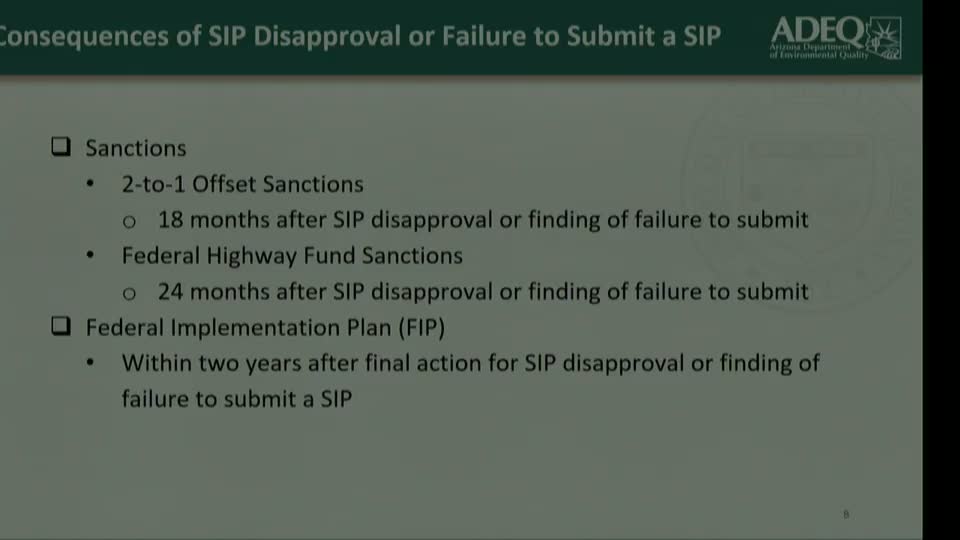EPA faces pressure to enforce stricter air quality controls
July 01, 2024 | Yuma County, Arizona

This article was created by AI summarizing key points discussed. AI makes mistakes, so for full details and context, please refer to the video of the full meeting. Please report any errors so we can fix them. Report an error »

In a recent government meeting, officials discussed pressing air quality concerns in the Yuma area, particularly regarding particulate matter (PM10) emissions. The Environmental Protection Agency (EPA) has mandated that if local stakeholders fail to develop an adequate State Implementation Plan (SIP) within 24 months, the agency will impose a federal implementation plan (FIP). This could lead to stricter controls that may not align with local interests.
The timeline is critical, as the area must meet National Ambient Air Quality Standards (NAAQS) by December 31, 2027. Failure to do so could escalate the region's status to \"serious nonattainment,\" requiring more stringent control measures and a mandated 5% annual reduction in PM10 emissions. The Arizona Department of Environmental Quality (ADEQ) is tasked with collaborating with stakeholders to create this plan, which is currently in development.
Officials reported progress in identifying significant sources of PM emissions and are working on control selections and motor vehicle emissions budgets. However, they acknowledged being behind schedule in submitting the SIP. Stakeholder engagement has been emphasized, with recent workshops yielding valuable feedback.
A significant point of discussion was the impact of external factors, such as smoke from agricultural activities in Mexico and emissions from heavy truck traffic, particularly from California. While the Clean Air Act allows for the exclusion of data from exceptional events, effective local controls must be in place to utilize this provision. The challenges posed by these external contributions to air quality were acknowledged, with officials stressing the need for a comprehensive approach to address both local and cross-border pollution sources.
The meeting underscored the urgency of developing a robust plan to improve air quality in Yuma, balancing regulatory requirements with the realities of external environmental impacts.
The timeline is critical, as the area must meet National Ambient Air Quality Standards (NAAQS) by December 31, 2027. Failure to do so could escalate the region's status to \"serious nonattainment,\" requiring more stringent control measures and a mandated 5% annual reduction in PM10 emissions. The Arizona Department of Environmental Quality (ADEQ) is tasked with collaborating with stakeholders to create this plan, which is currently in development.
Officials reported progress in identifying significant sources of PM emissions and are working on control selections and motor vehicle emissions budgets. However, they acknowledged being behind schedule in submitting the SIP. Stakeholder engagement has been emphasized, with recent workshops yielding valuable feedback.
A significant point of discussion was the impact of external factors, such as smoke from agricultural activities in Mexico and emissions from heavy truck traffic, particularly from California. While the Clean Air Act allows for the exclusion of data from exceptional events, effective local controls must be in place to utilize this provision. The challenges posed by these external contributions to air quality were acknowledged, with officials stressing the need for a comprehensive approach to address both local and cross-border pollution sources.
The meeting underscored the urgency of developing a robust plan to improve air quality in Yuma, balancing regulatory requirements with the realities of external environmental impacts.
View full meeting
This article is based on a recent meeting—watch the full video and explore the complete transcript for deeper insights into the discussion.
View full meeting
